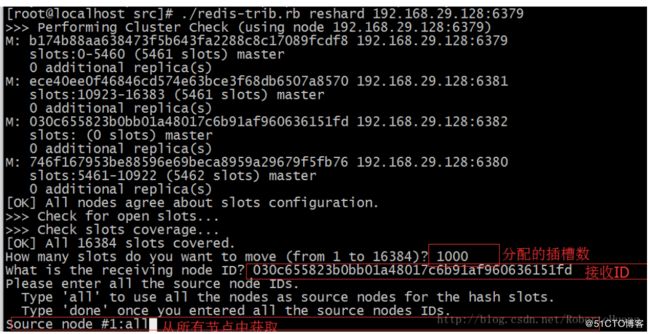1.为什么要有集群
由于Redis主从复制架构每个数据库都要保存整个集群中的所有数据,容易形成木桶效应,所以Redis3.0之后的版本添加特性就是集群(Cluster)
架构细节:
(1)所有的redis节点彼此互联(PING-PONG机制),内部使用二进制协议优化传输速度和带宽.
(2)节点的fail是通过集群中超过半数的master节点检测失效时才生效.
(3)客户端与redis节点直连,不需要中间proxy层.客户端不需要连接集群所有节点,连接集群中任何一个可用节点即可
(4)redis-cluster把所有的物理节点映射到[0-16383]slot上,cluster 负责维护node<->slot<->key
3.Redis Cluster环境搭建
3.1 分别修改配置文件,将端口分别设置为:6379、6380、6381,同时要设置pidfile文件为不同的路径。并且允许集群模式,修改集群配置文件指向地址,并且开启远程访问
修改配置文件 # vim /opt/redis/6379/6379.conf # 开启守护进程模式 daemonize yes # 修改启动端口为6379 port 6379 # 修改pidfile指向路径 pidfile /opt/redis/6379/redis_6379.pid # 开启允许集群 cluster-enabled yes # 修改集群配置文件指向路径 cluster-config-file nodes-6379.conf # 注释一下内容开启远程访问 # bind 127.0.0.1 端口不用放开 #aof开启 appendonly yes # 关闭保护模式 #protected-mode no 以此类推,修改端口6380及6381配置。
3.2 分别启动redis实例
# cd /opt/redis/redis-3.2.8/bin # ./redis-server /opt/redis/6379/6379.conf # ./redis-server /opt/redis/6380/6380.conf # ./redis-server /opt/redis/6381/6381.conf
3.3 查看redis状态 
说明redis已经是以集群方式启动了,但是redis之间关系还没确定下来
3.4 因为redis-trib.rb是由ruby语言编写的所以需要安装ruby环境
安装ruby环境 # yum -y install zlib ruby rubygems #gem install redis 报异常:解决 https://www.cnblogs.com/PatrickLiu/p/8454579.html
3.5 建立集群Redis关系
首先,进入redis的安装包路径下 # cd /opt/redis/redis-3.2.8/src 执行命令: # ./redis-trib.rb create --replicas 0 192.168.29.128:6379 192.168.29.128:6380 192.168.29.128:6381 说明:--replicas 0:指定了从数据的数量为0 注意:这里不能使用127.0.0.1,否则在Jedis客户端使用时无法连接到!
3.6 如果出现如下异常
sr/local/share/gems/gems/redis-3.2.1/lib/redis/client.rb:113:in `call': ERR Slot 0 is already busy (Redis::CommandError) from /usr/local/share/gems/gems/redis-3.2.1/lib/redis.rb:2556:in `block in method_missing' from /usr/local/share/gems/gems/redis-3.2.1/lib/redis.rb:37:in `block in synchronize' from /usr/share/ruby/monitor.rb:211:in `mon_synchronize' from /usr/local/share/gems/gems/redis-3.2.1/lib/redis.rb:37:in `synchronize' from /usr/local/share/gems/gems/redis-3.2.1/lib/redis.rb:2555:in `method_missing' from ./redis-trib.rb:212:in `flush_node_config' from ./redis-trib.rb:776:in `block in flush_nodes_config' from ./redis-trib.rb:775:in `each' from ./redis-trib.rb:775:in `flush_nodes_config' from ./redis-trib.rb:1296:in `create_cluster_cmd' from ./redis-trib.rb:1701:in `'
经检查,这是由于上一次配置集群失败时留下的配置信息导致的。 只要把redis.conf中定义的 cluster-config-file 所在的文件删除,重新启动redis-server及运行redis-trib即可。
3.7 建立集群Redis关系正常执行响应如下
>>> Creating cluster >>> Performing hash slots allocation on 3 nodes... Using 3 masters: 192.168.29.128:6379 192.168.29.128:6380 192.168.29.128:6381 M: d5d0951bb185a67a44d29dd2142170dbce84d977 192.168.29.128:6379 slots:0-5460 (5461 slots) master M: e41fe58ef571836d891656b482307628b3f7ab35 192.168.29.128:6380 slots:5461-10922 (5462 slots) master M: ddbc810661f81500059e0b22b1550713a0e3766d 192.168.29.128:6381 slots:10923-16383 (5461 slots) master Can I set the above configuration? (type 'yes' to accept): yes >>> Nodes configuration updated >>> Assign a different config epoch to each node >>> Sending CLUSTER MEET messages to join the cluster Waiting for the cluster to join... >>> Performing Cluster Check (using node 192.168.29.128:6379) M: d5d0951bb185a67a44d29dd2142170dbce84d977 192.168.29.128:6379 slots:0-5460 (5461 slots) master 0 additional replica(s) M: ddbc810661f81500059e0b22b1550713a0e3766d 192.168.29.128:6381 slots:10923-16383 (5461 slots) master 0 additional replica(s) M: e41fe58ef571836d891656b482307628b3f7ab35 192.168.29.128:6380 slots:5461-10922 (5462 slots) master 0 additional replica(s) [OK] All nodes agree about slots configuration. >>> Check for open slots... >>> Check slots coverage... [OK] All 16384 slots covered. 成功
***************************************************************************** 注:redis集群 Waiting for the cluster to join 一直等待 ./redis-trib.rb create --replicas 1 XXXX:PORT1 XXXX:PORT2 .... 的时候 一直等待 Waiting for the cluster to join 很久都没有反应 原因: redis集群不仅需要开通redis客户端连接的端口,而且需要开通集群总线端口 集群总线端口为redis客户端连接的端口 + 10000 如redis端口为6379 则集群总线端口为16379 故,所有服务器的点需要开通redis的客户端连接端口和集群总线端口 注意:iptables 放开,如果有安全组,也要放开这两个端口 *******************************************************************************
3.9 测试
3.9.1 测试插入数据  因为abc的hash槽信息是在6380上,现在使用redis-cli连接的6379,无法完成set操作,需要客户端跟踪重定向。使用redis-cli -c
因为abc的hash槽信息是在6380上,现在使用redis-cli连接的6379,无法完成set操作,需要客户端跟踪重定向。使用redis-cli -c
4. 插槽的概念及插槽分配
整个Redis提供了16384个插槽,也就是说集群中的每个节点分得的插槽数总和为16384。./redis-trib.rb 脚本实现了是将16384个插槽平均分配给了N个节点。当我们执行set abc 123命令时,redis是如何将数据保存到集群中的呢?执行步骤:
i.接收命令set abc 123ii.通过key(abc)计算出插槽值,然后根据插槽值找到对应的节点。abc的插槽值为:7638iii.重定向到该节点执行命令123
注意:如果插槽数有部分是没有指定到节点的,那么这部分插槽所对应的key将不能使用。
5.新增集群节点
5.1 再开启一个实例的端口为6382 配置同上 
6.删除集群节点
想要删除集群节点中的某一个节点,需要严格执行2步:
6.1.将这个节点上的所有插槽转移到其他节点上
6.1.1执行脚本:./redis-trib.rb reshard 192.168.29.128:6382
6.1.2选择需要转移的插槽的数量,因为6382有100个,所以转移100个
6.1.3输入转移的节点的id,我们转移到6379节点
6.1.4输入插槽来源id,也就是6382的id
6.1.6查看集群节点信息,可以看到6380节点已经没有插槽了 
7. Redis Cluster高可用
7.1 假设集群中某一节点宕机 测试数据写入操作 
我们尝试执行set命令,结果发现无法执,行集群不可用了?? 这集群也太弱了吧??
7.3 本教程不详细介绍集群中主从复制架构的具体安装,只提一下过程
7.3.1 为每个集群节点添加Slave,形成主从复制架构,主从复制架构可参考:主从复制架构,搭建结构如下所示
6379(Master) 6479(Slave of 6379) 6579(Slave of 6379) 6380(Master) 6480(Slave of 6380) 6580(Slave of 6380) 6381(Master) 6481(Slave of 6381) 6581(Slave of 6381)
7.3.2 为每个主从复制架构添加哨兵集群,哨兵模式集群可参考:哨兵模式集群
7.3.3 创建集群 使用如下命令
./redis-trib.rb create --replicas 2 192.168.29.128:6379 192.168.29.128:6380 192.168.29.128:6381 192.168.29.128:6479 192.168.29.128:6480 192.168.29.128:6481 192.168.29.128:6579 192.168.29.128:6580 192.168.29.128:6581
参考:
https://blog.csdn.net/robertohuang/article/details/70833231












